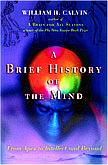|
William H. Calvin  SEATTLE, WASHINGTON 98195-1800 USA |
|
VIDEO This what-to-do-about-it
lecture (also available as a
podcast
mp3) for UW
oceanography focuses on abrupt climate changes since 1976, how to
head off more, and how to use the oceans to sequester enough carbon.
Several slides are for the experts, but the rest is suitable for a general
scientific audience. Others familiar with the climate story will be able
to follow it as well.
|
The climate talk bio: William H. Calvin, Ph.D., is a professor at the University of Washington School of Medicine, affiliated with the Program on Climate Change. He is the author of Global Fever: How to Treat Climate Change (University of Chicago Press 2008, see Global-Fever.org) and thirteen earlier books for general readers. He studies brain circuitry, ape-to-human evolution, climate change, and civilization’s vulnerability to abrupt shocks. In Global Fever, he writes: "The climate doctors have been consulted; the lab reports have come back. Now it’s time to pull together the Big Picture and discuss treatment options. At a time when architects are thinking ahead to more efficient buildings and power planners are extolling the virtues of “renewable energy,” the climate modelers have discovered that long-term planning will no longer suffice. Our fossil fuel fiasco has already painted us into a corner such that, if we don’t make substantial near-term gains before 2020, the long-term is pre-empted, the efforts all for naught. We are already in dangerous territory and have to act quickly to avoid triggering widespread catastrophes. The only good analogy is arming for a great war, doing what must be done regardless of cost and convenience." His climate talk in Beijing at the Great Hall of the People is available in streaming video from the World Bank as are other recent lectures at NASA and Rice University. | |
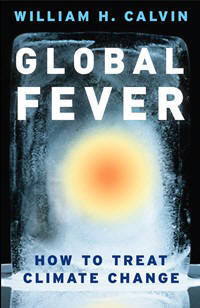 Global Fever How to Treat Climate Change from the University of Chicago Press (2008).
Recent climate talks “The Great Use-it-or-lose-it Intelligence Test” about the climate crisis was my Crawford Memorial Lecture at the Great Hall of the People in Beijing, audience of 800 from 60+ countries.1. The climate talk in streaming video (RealMedia*) 2. Color slides in PDF (might wish to download before watching video). 3. Written version (28-page World Bank pamphlet) in PDF.
President's Lecture Series,
Rice University (same topic as Beijing) in MP3 and streaming video.
| ||
|
INTERVIEWS 
Obama embraces nuclear power . Rep. Tom Price, R-Ga., and Dr. William Calvin, a professor at the University of Washington in Seattle, discuss President Barack Obama’s plan to lessen America’s dependence on foreign oil and create more jobs.[MSNBC, Dylan Ratigan Show, 16 February 2010.] The Ed Mays interview about climate  PODCASTS PODCASTS
mp3 files to download or
play
Climate creep and climate leap The
U Vic evening
lecture
. I was interviewed
for an hour on NPR's The Connection, talking
about brains, climate, and bounceback.
|
|
William H. Calvin, a professor at the University of Washington School of Medicine, is the author of 14 popular books on science, mostly about brains, evolution, and climate change. 

They have been translated into 14 languages. He won the Phi Beta Kappa book prize for science as literature and the Kistler Book Prize. His occasional magazine articles include an Atlantic Monthly cover story, "The Great Climate Flip-flop." Op-ed-sized pieces can be found at wcalvin.dailykos.com. |
|
Books, Articles, and Talks mostly on brains, climate, evolution, and where we're heading.
|
Recent Additions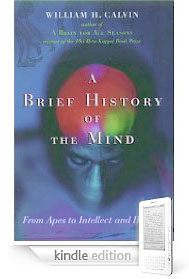
|
Talks and Interviews
|
General
information for lecture organizers |
 On the experimental side of neurophysiology, I have recorded from single neurons in species ranging from sea slugs in vitro to humans in situ. My theoretical work was originally on cable properties of neurons but more recently has been on the emergent properties of recurrent excitatory networks in the superficial layers of cerebral cortex. A quick reference is "Cortical Columns, Modules, and Hebbian Cell Assemblies," in: The Handbook of Brain Theory and Neural Networks, edited by Michael A. Arbib (Bradford Books/MIT Press), pp. 269-272 (1995).There are glimpses of my research on neurons in the book that George Ojemann and I wrote on cerebral function, Conversations with Neil's Brain, which is particularly suitable for students and general readers. You can now print out some of my research papers as PDF files. |
.jpg)  Like a lot of other people, I've
had an interest in the "big brain problem," how evolution reorganized and
enlarged the ape brain in the last few million years. Abrupt climate
change is an important driver for hominid evolution, and so I've been
following paleoclimate studies and the related oceanography since 1984 --
which is how I came to write "The Great Climate
Flip-flop" for The Atlantic
Monthly.
More... And see: Like a lot of other people, I've
had an interest in the "big brain problem," how evolution reorganized and
enlarged the ape brain in the last few million years. Abrupt climate
change is an important driver for hominid evolution, and so I've been
following paleoclimate studies and the related oceanography since 1984 --
which is how I came to write "The Great Climate
Flip-flop" for The Atlantic
Monthly.
More... And see:
"The Unitary Hypothesis: A Common Neural Circuitry for Novel Manipulations, Language, Plan-ahead, and Throwing?" In Tools, Language, and Cognition in Human Evolution, edited by Kathleen R. Gibson and Tim Ingold. Cambridge University Press, pp. 230-250 (1993). My New York Times book review is a good introduction to the language aspects. Older webbed reprints include my 1983 Journal of Theoretical Biology throwing article.
My 2004 book, A Brief History of the Mind: From Apes to
Intellect and Beyond (Oxford UP), looks back at the simpler versions
of mental life in apes, Neanderthals, and our ancestors, back before our
burst of creativity started 50,000 years ago in the transition to
behaviorally-modern humans. |
I tend to think that the fancier mental processes (language, planning, music, logic) utilize a form of Darwinian process that operates in milliseconds to minutes. See
|
 GALLERY
GALLERY
More slide shows
at:
plus portraits of the great apes.
TALKING
|
Current One-hour Lecture Topics
|
WRITING
| This would ordinarily be the section labeled TEACHING but I seem to teach the general public rather than undergraduates. |
|
University of Chicago Press, 2002 I t's my book about what sudden climate flips did to human evolution over the last 2.5 million years, how the climate lurches resonated with punctuated equilibria to pump up brain size.It is designed as a travelogue, as if it were a seminar by e-mail with a traveling professor. It begins at Darwin's home near London, tours African fossil sites while discussing the evolution of brains, and ends with a flight from Copenhagen to Seattle that flies over the ice cap of Greenland and the vulnerable sites nearby where the Gulf Stream sinks. It includes the climate flip history and oceanographic mechanisms that I described in my Atlantic Monthly cover story, "The Great Climate Flip-flop."
|
It was the Scientific American Book of the Month, won
the 2002 Phi Beta Kappa book prize for “outstanding
contributions by scientists to the literature of science,” and won the
2006 Walter P. Kistler Book Award, which recognizes authors of
science-based books that make important contributions to the public’s
understanding of the factors that may impact the long-term future of
humanity. At
many bookstores as well as:
University of Chicago Press. |
The publisher's selection for the back cover:
|
William H. Calvin and
Derek Bickerton, Lingua ex Machina: Reconciling
Darwin and Chomsky with the Human Brain (MIT Press, 2000), the book
we wrote at Bellagio.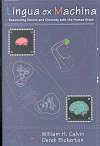
Chomsky’s Universal Grammar, the intellectual spectator sport of the last four decades, implies an innate brain circuitry for syntax. That opens up an evolutionary can of worms, suggesting a large step up to human-level language abilities – one without the useful-in-themselves intermediate steps usually associated with Darwinian gradualism. That macromutations were suggested is only one example of the deus ex machina quality of most attempts to explain the origins of language. A proper lingua ex machina would be a language machine capable of nesting phrases and clauses inside one another, complete with evolutionary pedigree. Such circuitry for structured thought might also facilitate creative shaping up of quality (figuring out what to do with the leftovers in the refrigerator), contingency planning, procedural games, logic, and even music. And enhancing structured thought might give intelligence a big boost. Solve the cerebral circuitry for syntax, and you might solve them all. The authors offer three ways for getting from ape behaviors to syntax. They focus on the transition from simple word association in short sentences (protolanguage) to longer recursively structured sentences (requiring syntax).... |
AVAILABLE: The US and UK hardcover edition is widely
available. The Spanish translation is from Editorial Gedisa of
Barcelona.
Hardcover, ISBN 0-262-032732 Paperback, ISBN 0-262-531984 |
 The Cerebral Code: Thinking a Thought in the Mosaics
of the Mind, from MIT Press (1996). Unlike the other books, it's
more for scientists than general readers. Chapter titles are: The Representation Problem and the Copying Solution,
Cloning in Cerebral Cortex, A Compressed Code Emerges, Managing the
Cerebral Commons, Resonating with your Chaotic Memories, Partitioning the
Playfield, Intermission Notes, The
Brownian Notion, Convergence Zones with a Hint of Sex, Chimes on the
Quarter Hour, The Making of Metaphor, Thinking a Thought in the Mosaics of
the Mind. The Cerebral Code: Thinking a Thought in the Mosaics
of the Mind, from MIT Press (1996). Unlike the other books, it's
more for scientists than general readers. Chapter titles are: The Representation Problem and the Copying Solution,
Cloning in Cerebral Cortex, A Compressed Code Emerges, Managing the
Cerebral Commons, Resonating with your Chaotic Memories, Partitioning the
Playfield, Intermission Notes, The
Brownian Notion, Convergence Zones with a Hint of Sex, Chimes on the
Quarter Hour, The Making of Metaphor, Thinking a Thought in the Mosaics of
the Mind. |
GENERALLY AVAILABLE
Softcover, US$14.00; ISBN 0-262-53154-2. The German translation, Die Sprache des Gehirns: Wie in unserem Bewußtsein Gedanken entstehen, is at amazon.de. |
| "... in The
Cerebral Code: Thinking a Thought in the Mosaics of the Mind, Calvin
lays out a wide-ranging and innovative theory linking the neural structure
of the cortex to thought, language, and consciousness." "... a fascinating
and readable presentation of a novel and radical approach to bridging the
gap between mind and brain." --Richard Cooper, in The Times [London] Higher Education
Supplement
"[Calvin's CEREBRAL CODE]
basic model can be applied to problems such as the sequences needed for
body movements and in language, making associations, imagining, and
thought pathologies. Finally, he goes for gold with a thought experiment,
testing his [cortical Darwin Machine] theory on consciousness and a
mechanistic outline for Universal Grammar.... [Calvin's is] a vision that
is now all too rare. Right or wrong, his ideas should stimulate many to
think more broadly about the dynamic processes of the cortex...." --Jennifer Altman, in New Scientist (23 November
1996) | |
 How Brains Think: Evolving Intelligence, Then and
Now in the Science
Masters series from Basic Books in the USA (1996) and
Weidenfeld and Nicolson in the UK. There are 12 translation editions (including
Japan and China). A Book of the Month Club
selection. It expands on the Scientific
American article to address the evolution of consciousness,
intelligence, and language. The chapter titles are What to Do Next,
Evolving a Good Guess, The Janitor's Dream, Evolving Intelligent Animals,
Syntax as a Foundation of Intelligence, Evolution On-The-Fly, Shaping Up
an Intelligent Act from Humble Origins, Prospects for a Superhuman
Intelligence. How Brains Think: Evolving Intelligence, Then and
Now in the Science
Masters series from Basic Books in the USA (1996) and
Weidenfeld and Nicolson in the UK. There are 12 translation editions (including
Japan and China). A Book of the Month Club
selection. It expands on the Scientific
American article to address the evolution of consciousness,
intelligence, and language. The chapter titles are What to Do Next,
Evolving a Good Guess, The Janitor's Dream, Evolving Intelligent Animals,
Syntax as a Foundation of Intelligence, Evolution On-The-Fly, Shaping Up
an Intelligent Act from Humble Origins, Prospects for a Superhuman
Intelligence. |
AVAILABLE: The US and UK editions are out in
paperback.
|
| "[HOW BRAINS THINK], part of the
Science Masters series, offers an exquisite distillation of his key ideas.
He's a member of that rare breed of scientists who can translate the
arcana of their fields into lay language, and he's one of the best. There
are other, competing theories for explaining consciousness. But Mr.
Calvin, so lyrical and imaginative in his presentation, draws you into his
world of neural Darwinism and inspires you to read more." --Marcia Bartusiak, in New York Times Book Review,
(17 November 1996) "Nothing in showbiz right now is as thrilling as the
debate surrounding consciousness. Darwinism decentred the body. The new
debate is scarier: it decentres the mind. This goes down badly at dinner
parties. Quote, say, Daniel Dennett's Consciousness
Explained over dinner, within seconds your guests will have worked
themselves up into an orgy about light bulbs having souls or Psion
organisers writing Shakespeare. -- Simon Ings, in New Scientist (8 March
1997)
"Calvin is fizzing with ideas and this is a
provocative, stimulating book." -- Sunday Times
(London)
"This book sets out what we know about our brains with
remarkable skill." -- Financial Times
(London)
The Hungarian, German, Romanian, Portuguese, Korean, Japanese, Polish, Chinese, Taiwan, and UK editions of How Brains Think are available. | |
|
|
AVAILABILITY widespread (softcover, US$12; ISBN 0-201-48337-8). German and Dutch
translations.
|
Authors Guild reprint editions of the first six books are available.
 How the Shaman Stole the Moon (Bantam 1991; Authors Guild reprint 2001) is
my archaeoastronomy book, a dozen ways of predicting eclipses — those
Paleolithic strategies for winning fame and fortune by convincing people
that you're (ahem) on speaking terms with whoever runs the heavens. How the Shaman Stole the Moon (Bantam 1991; Authors Guild reprint 2001) is
my archaeoastronomy book, a dozen ways of predicting eclipses — those
Paleolithic strategies for winning fame and fortune by convincing people
that you're (ahem) on speaking terms with whoever runs the heavens.SUPPLEMENT: "Leapfrogging Gnomons" describes how to survey a 700-km north-south line without modern instruments. |
Available in an Authors Guild
reprint edition through amazon.com and other
booksellers.  Also in German
translation.
Also in German
translation.
|
 The Ascent of Mind
(Bantam 1990; Authors
Guild reprint 2001) is my book on the ice ages and how human intelligence
evolved; the "throwing theory" is one aspect. All chapters
are now webbed. The Ascent of Mind
(Bantam 1990; Authors
Guild reprint 2001) is my book on the ice ages and how human intelligence
evolved; the "throwing theory" is one aspect. All chapters
are now webbed. My Scientific American article, "The emergence of intelligence," (October 1994) also discusses ice-age evolution of intelligence. |
|
 The Cerebral
Symphony (Bantam 1989;
Authors Guild reprint 2001) is my book on animal and human consciousness,
using the setting of the Marine Biological Labs and Cape
Cod. The Cerebral
Symphony (Bantam 1989;
Authors Guild reprint 2001) is my book on animal and human consciousness,
using the setting of the Marine Biological Labs and Cape
Cod. |
 There are
German and Dutch
translations. The original English is now available in an Authors
Guild reprint edition via amazon.com and other
booksellers: There are
German and Dutch
translations. The original English is now available in an Authors
Guild reprint edition via amazon.com and other
booksellers:
|
 The River That Flows Uphill (Sierra Club Books 1987; Authors Guild reprint
2001) is my river diary of a two-week whitewater trip through the bottom
of the Grand Canyon, discussing everything from the Big Bang to the Big
Brain. It became a bestseller in German translation in
1995. The River That Flows Uphill (Sierra Club Books 1987; Authors Guild reprint
2001) is my river diary of a two-week whitewater trip through the bottom
of the Grand Canyon, discussing everything from the Big Bang to the Big
Brain. It became a bestseller in German translation in
1995. |
 German and Dutch translations
are available, and the original English version is available in an Authors
Guild reprint edition through amazon.com and
other booksellers. German and Dutch translations
are available, and the original English version is available in an Authors
Guild reprint edition through amazon.com and
other booksellers.
|
The Throwing Madonna:
Essays on the Brain
(McGraw-Hill 1983, Bantam 1991, Authors Guild reprint 2001) is a group of
17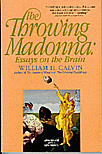 essays: The
Throwing Madonna. The Lovable Cat: Mimicry Strikes Again. Woman the
Toolmaker? Did Throwing Stones Lead to Bigger Brains? The Ratchets of
Social Evolution. The Computer as Metaphor in Neurobiology. Last Year in
Jerusalem. Computing Without Nerve Impulses. Aplysia, the Hare of the Ocean. Left Brain, Right Brain:
Science or the New Phrenology? What to Do About Tic Douloureux. The
Woodrow Wilson Story. Thinking Clearly About Schizophrenia. Of Cancer
Pain, Magic Bullets, and Humor. Linguistics and the Brain's Buffer.
Probing Language Cortex: The Second Wave, and The Creation Myth, Updated: A Scenario for
Humankind. essays: The
Throwing Madonna. The Lovable Cat: Mimicry Strikes Again. Woman the
Toolmaker? Did Throwing Stones Lead to Bigger Brains? The Ratchets of
Social Evolution. The Computer as Metaphor in Neurobiology. Last Year in
Jerusalem. Computing Without Nerve Impulses. Aplysia, the Hare of the Ocean. Left Brain, Right Brain:
Science or the New Phrenology? What to Do About Tic Douloureux. The
Woodrow Wilson Story. Thinking Clearly About Schizophrenia. Of Cancer
Pain, Magic Bullets, and Humor. Linguistics and the Brain's Buffer.
Probing Language Cortex: The Second Wave, and The Creation Myth, Updated: A Scenario for
Humankind.Note that my throwing theory for language origins (last 3 essays) has nothing to do with the title essay: "The throwing madonna" essay is a parody (involving maternal heartbeat sounds!) on the typically-male theories of handedness. |
Japanese
translation available, and the Authors Guild reprint edition is available
through amazon.com and other
booksellers: 
|
  Inside the Brain (NAL,
1980; Authors Guild reprint 2001), co-authored with my neurosurgeon
colleague, George Ojemann, is back in print. Note that it was effectively
replaced by our Conversations with
Neil's Brain. except that space limitations caused us to omit the
subcortical aspects which are prominent in Inside
the Brain. The Authors Guild reprint edition is available through amazon.com and other
booksellers. Inside the Brain (NAL,
1980; Authors Guild reprint 2001), co-authored with my neurosurgeon
colleague, George Ojemann, is back in print. Note that it was effectively
replaced by our Conversations with
Neil's Brain. except that space limitations caused us to omit the
subcortical aspects which are prominent in Inside
the Brain. The Authors Guild reprint edition is available through amazon.com and other
booksellers.
|
| amazon.com link for
|
Jared Diamond, Collapse How societies choose to fail or succeed Viking, 2005. "Pollyanna reviews Cassandra?" Unpublished (as usual) letter to
NY Times. |
This section expanded so much that it now has its own
"page": The Bookshelf. It
runs heavily to the likes of the Three D's (Darwin-Dawkins-Dennett),
leavened by a little Tom Stoppard.
Favorite Web Siteshttp://williamcalvin.com/img/yellow.gif" width=14 height=14 > Neuro.........
I am quoted
extensively in the new GBN book, What's Next? (See excerpts.) My bonobo page and my Down House page. Streaming audio of my GBN talk, "Are humans just
out of beta?" E. Simon Hanson, "An interview with William
H. Calvin," at www.brainconnection.com.
|
This work is licensed under a Creative Commons License.
copyright ©1994-2007 by William H. Calvin
| William H. Calvin |
|






















